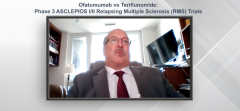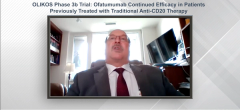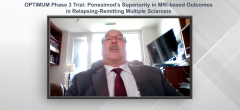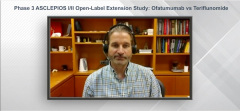
OPTIMUM: Ponesimod Superiority in MRI-based Outcomes in RRMS
Episodes in this series

An overview of the phase 3 OPTIMUM study involving ponesimod and how the reduction in MRI-based outcomes, including brain atrophy, is significant in supporting the clinical outcome of relapse rate reduction in patients with relapsing-remitting multiple sclerosis.
Mark Freedman, MD, MSc: The next study we’re going to talk about is another recently studied medicine that has yet to be approved anywhere in the world. This is ponesimod, which was tested against an active comparator, teriflunomide, in the relapsing-remitting population. That was called the OPTIMUM study. Ponesimod is a different S1P [sphingosine 1-phosphate] receptor agonist. There are now 4 or 5 of these drugs. This particular drug was looked at in the OPTIMUM study against teriflunomide and shown to be superior in terms of their primary outcome measure, which was relapse rate.
There have been a number of subanalyses that were planned as part of the OPTIMUM study, so this presentation focuses on the MRI-based outcomes in these patients. We have the top-line results, but we wanted to see what all the different detailed results were. We’re now looking at including prespecified MRI end points and NEDA, no evidence of disease activity, which is seen in some patients. The entire patient population was analyzed. This is not a subanalysis, per se, but looked more at the total MRI outcome. They looked at everything in terms of MRI activity, including brain atrophy as measured by the change in brain volume using the SIENA [Structural Image Evaluation Using Normalization of Atrophy] technique.
In this study, 87% of the patients completed the study and the images were available for analysis. They showed the continued significance of ponesimod’s superiority over teriflunomide on nearly every outcome measure out to week 108. They did it by various means, but in particular, when one looks at the changes in brain volume—in other words, the retardation or prevention of brain atrophy—the significance was there. The change from baseline was 0.91% in the ponesimod arm vs 1.25% in the teriflunomide arm. There was a significant reduction in T2 lesion load. I don’t want to give you all the numbers, but it was highly statistically significant. Mean number of new or enlarging T2 lesions was also statistically significant. The odds of having no new, enlarging T2 lesions on ponesimod vs teriflunomide were 1.7 to 1, or almost 2 times more likely. The mean number of new Gad [gadolinium-enhancing] T1 lesions, or hot lesions, was substantially reduced. Some reductions were out to point 3 or 4 zeros of significance.
Finally, the NEDA-3—which is no relapse, no new MRI lesions, and no disease or confirmed disability progression—shows the advantage of ponesimod over teriflunomide. The actual numbers here are 28% of the ponesimod patients vs 18.3% of the teriflunomide patients achieved NEDA-3. If you add in the atrophy, this is now called NEDA-4. If you have less than 0.4% per year of atrophy, in addition to not having a measured activity the traditional way, you’d be considered NEDA-4. Fifteen percent of participants on ponesimod vs 8.5% of those on teriflunomide reached the NEDA-4. That was also quite statistically significant.
However you slice and dice the MRI outcomes, the ponesimod shows superiority over teriflunomide on all these aspects. That is supportive of the clinical outcome, which is the reduction of relapse rate.
The whole point of doing these in-depth views of the MRI outcomes is to substantiate as much as possible that the clinical outcome, which is statistically significant, is meaningful.
It is meaningful in terms of all the different, more sensitive measures of disease activity that one can measure using MRI, including the important outcome of brain atrophy, which has coincided nicely over years with degree of disease progression. I say that because this particular study did not show superiority on the outcome measure of disease progression. For that matter, all of the comparator studies using S1P receptor agonists have failed to show this against their active comparator for a number of reasons. The active comparator, which in this case is teriflunomide, does have an effect on slowing disease progression. The study was not powered to look at disease progression as a primary outcome. One expects that disease progression in this early group would be very low. They don’t have the power to see that, but when you see it on atrophy, you get the sense that had they powered a study to look at disease progression, you might have seen a benefit.
Newsletter
Keep your finger on the pulse of neurology—subscribe to NeurologyLive for expert interviews, new data, and breakthrough treatment updates.



































